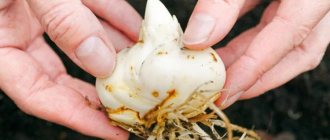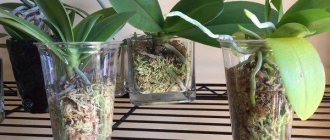The abundance of flowering, the brightness of the shades of the petals and the variety of varieties have ensured peonies steady popularity among Russian gardeners. But without replanting, the condition of the bush gradually worsens. The procedure must be carried out correctly and on time so as not to further harm the plants.
- 2 Features and timing of transplantation
2.1 Video: spring transplantation of peonies
- 3.1 Video: dividing a peony bush and replanting it
Why is a transplant needed?
The best period for replanting is autumn
One of the features of peonies is their fragile, deep-lying root system. Therefore, culture transplantation is painful. After this procedure, the divisions take a long time to recover, and often begin to bloom only after 2-3 years.
It is important to know when to repot peonies and how to do it carefully while minimizing stress to the plants. It is impossible to do without this procedure. Upon reaching the age of 6-7 years, the bushes begin to produce less lush flowering, the flowers become smaller. Sometimes they stop appearing altogether. This is explained by the fact that the roots thicken and suffer from nutrient deficiency.
Thickening of the root system
The root system of an adult plant looks like a dense plexus of thick roots forming nodes. They are often empty and rotten on the inside. Underground parts often become a haven for rodents, which make passages and burrows inside. As a result, root growth slows down significantly, and the green mass stops developing, not receiving sufficient nutrition.
Important! Old bushes lose strength, do not reproduce, and therefore lose the ability to throw out buds. Flowering stops altogether or becomes scarce.
When the root system thickens and the crop stays in the same place for a long time, soil depletion occurs. Plants begin to suffer from a deficiency of essential microelements.
Fertilizing, which is usually applied to young bushes during planting, lasts for several years. Then the peonies are fertilized every year, but this does not allow them to fully satisfy their needs for nutrients, since the crop receives the bulk of them from the soil.
The root system of peonies is located deep under the surface of the earth, does not spread to the sides, and the fertile layer lies at a depth of about 20 cm. Therefore, the roots cannot absorb the required amount of microelements, the plants do not have enough strength for active growth and frequent flowering.
Features of caring for peonies after transplantation: 5 rules
| Rule 1. Watering After transplantation, the peony most needs watering. It is advisable, even on warm autumn days, before the onset of frost, to water the transplanted bushes well a couple of times. It is important to prevent moisture stagnation in the root zone. This can lead to rotting of the roots at the cut site or the appearance of other fungal diseases. For watering, I recommend using settled, not cold water - the roots don’t need any extra stress | |
| Rule 2. Mulching After transplanting and the first watering, the soil should be covered with a layer of mulch. I always cover with peat moss, but any mulching material will do. The main thing is to make a thicker layer for the winter - up to 25 cm or lay spruce branches on top of a layer of normal thickness. This needs to be done as soon as the first frosts arrive, not earlier. Otherwise, the plant may sag a little, and in the spring it will hurt. | |
| Rule 3. Loosening Once a week, the root circle needs to be loosened. As a rule, the procedure is carried out after watering so that a hard crust does not form on the surface of the earth, preventing oxygen from reaching the roots. | |
| Rule 4. Removing weeds Peony loves space. It does not tolerate close proximity to other garden crops very well and reacts extremely negatively to the appearance of weeds in the root zone. Usually weeds are removed during loosening - always with the roots | |
| Rule 5. Feeding The first 1–2 years after transplantation, the peony does not need feeding. In the third year and every spring thereafter, I begin to add cowshed dissolved in water (ratio 1:20):
|
To summarize, we can say that caring for peonies after transplantation is no different from the usual care of garden crops. The only thing is, maybe you should just be a little more attentive to the flower, inspect the plant more often for pests and diseases. And remember that the key to good growth and development of a peony is regular care.
Choosing a new place
Culture does not like strong winds and drafts
When to replant primrose - in spring, summer or autumn
The main requirement that a new site must meet is good lighting. Peonies are a light-loving crop. They can grow in light partial shade. But if they remain in dense shade, for example, from trees or buildings, for at least 1 hour a day, then flowering worsens and the bushes wither.
- The future flower bed with peonies should be ventilated so that the plants are not affected by fungus.
- Close proximity to buildings is not recommended because in the summer heat, brick or concrete walls reflect heat. This may burn the plants.
- And nearby shrubs or trees can deprive peonies of nutrients and water.
Therefore, when deciding when to transplant peonies to another place, it is important to pay attention to the selection of the site. It is better to leave a central place for them in the garden or in a flower bed, so that trees and buildings do not block the bushes from the light.
The crop does not have such high demands on soil composition. She feels comfortable on any garden soil. Drained loamy soil is considered the best option.
Note! Peonies love good moisture, but do not tolerate stagnant moisture. Their root system begins to rot.
The soil for normal root development must be soft, thoroughly and deeply cultivated, otherwise the root system will remain in the top layer of soil. In summer it dries out quickly, which threatens the bushes with a lack of moisture, slower growth, and lack of flowering. If the soil in the new area for peonies is poor, it must be enriched with fertilizers.
Why are flowers replanted?
After 5-10 years, a plant growing in one place begins to slowly die. This is due to the fact that cavities form in the root system in which insects settle, destroying the flower.
Also, every year, renewal buds develop deeper underground. As a result, the plant spends all its energy to germinate and flowering becomes scarce or disappears altogether.
Wilting and lack of flowering are the main signs that it is time to divide the flower bushes and transplant them from one place to another.
Time for transfer
When is it better to replant plants, in spring or autumn? The most suitable time to transplant peonies is the beginning of autumn (late August or early September). A later transplant is possible, but in this case the use of growth stimulants is required, otherwise the seedling will not have time to take root before the onset of cold weather.
Important! Transplanting flowering peonies is unacceptable, as they will not have the strength to take root. Flowering peonies take root worse and may not give roots at all, since their internal processes are tuned to flowering.
Is it possible to replant in the summer after flowering? If early replanting is necessary, it should be done in spring (May) or summer, after flowering. This will allow the plant to take root better.
Features of planting at different times of the year
Healthy and intact suction roots are the key to successful establishment of young plants
How to feed peonies at the dacha in autumn and spring
To determine how to plant peonies and when to do it, you need to have an idea of the characteristics of their root system.
- Its central, most massive part serves as a kind of storehouse for nutrients. It is this that supports the plant during wintering and protects it from the cold.
- Thinner processes extend from it. The density and abundance of flowering bushes depend on their condition, since replacement buds and young stems are formed on these roots. Sprouts in the form of light, thin root shoots are formed in the fall, in September.
- Another important part of the root system is the suction shoots, which can be thought of as a thin web that collects micronutrients and moisture. To avoid damaging it, when planting peonies it is necessary to prepare a wide and deep hole.
To choose the right moment when you can replant peony bushes, you need to know the peculiarities of crop adaptation at different times of the year.
in spring
Transplanting peonies in spring has one significant drawback: it is easy to be late with this work.
With the end of winter, the plants wake up. There is a rapid growth of suction roots. If you start replanting the bush during this period, these roots can be damaged, which threatens the death of the entire plant. It will not receive nutrition and will quickly use up the reserve that has accumulated in the massive central roots.
Important! Bushes that have been transplanted in the spring often become overgrown with a thick green mass. But next winter they do not survive, since over the summer their storehouse of useful substances is used up, and there is not enough for the winter.
If you still replant the bushes after wintering, then this should be done as early as possible, immediately after the snow cover melts, before the plants awaken. By this time, the roots do not have time to wake up. They begin to develop in a new area.
In summer
In June and July, the crop actively grows green mass, and the suction roots have time to grow and gain a foothold in the soil in the spring. Their development slows down, but the roots actively extract moisture and nutrients. When buds form on the bushes, the main forces of the plant are directed to the flowers.
If you replant peonies in the summer, the suction roots will inevitably be damaged and the nutrition of the bushes will deteriorate. In the new area, neither the development of new roots nor the adaptation of old ones occurs. The only source of nutrition is the reserves already made by the plants. But there are not enough of them for wintering, which often leads to the death of peonies.
According to statistics, most bushes transplanted in summer wither within a month
in autumn
In autumn, peonies stop blooming and begin to prepare for winter. The green mass is not growing. Plants store nutrients. Their absorbent roots actively extract nutrients and grow quickly. This period is considered the best time to plant peonies. The bushes are ready to be divided and moved to a new site. The roots are ready for the winter cold.
One month is enough for the culture to take root normally. Before frost sets in, peonies have time to grow suction roots. In the northern regions, planting can be done as early as mid-August. In the middle zone, the optimal time is in September, and in the south it lasts until mid-October.
Note! When replanting bushes in the fall, it is important not to be late.
On average, at the end of September there begins a period of active growth of storage roots, where plants retain a supply of necessary elements. They become denser and more voluminous. The transplant must be carried out before this time, otherwise the bush will not survive the winter.
When is it better to replant peonies, in spring or autumn?
It is recommended to replant peonies once every 5-6 years. It is best to do this at the end of the spring-summer season. The optimal period is September-October, before frosts begin. In the Moscow region, work can begin at the end of August.
When choosing the most suitable time for replanting plants, it is necessary to take into account the climatic conditions of the region and the weather. So, in the north of the country, where it is noticeably colder, this is done earlier, in the southern regions - later.
Preparing the site for transplantation
How to propagate peonies for planting in spring and autumn
You need to start preparing a flower bed for peonies 2-4 weeks before the planned planting date, so that the soil settles and compacts. Planting pits are prepared for the crop.
- Their width and depth should be about 0.5 m.
- The bottom is thoroughly loosened.
- Before planting, a mixture of humus and garden soil is poured into the hole with the addition of 200 g of superphosphate and 500 g of bone meal.
If the site is located in a lowland, then the flower beds must be raised and a drainage layer must be installed in the planting holes. To do this, they should be deepened by 20 cm and filled with coarse sand and gravel.
Some gardeners use the trench method when planting peonies. When it becomes necessary to transplant a large number of plants, instead of individual holes, they dig trenches 0.5 m wide and deep.
Preparing the planting hole
We recommend reading our other articles
- Food for large turkeys
- The benefits and harms of garlic
- What can beds be made from?
- Shallot
Preparation of the planting pit begins a month or at least 2 weeks before the procedure. The pit dimensions are 60 cm deep and 55 cm in diameter. If several peony bushes are planted at once, then a distance of 1-1.5 meters must be maintained between them. Drainage is immediately poured into the bottom of the hole in a layer of 10-15 cm. This can be expanded clay, pebbles, crushed stone or a similar material. A little plain sand is poured on top. And the hole is left until planting.
Preparation of the planting pit begins a month or at least 2 weeks before transplantation
When digging a hole, it is necessary to set aside the top layer of soil. A bucket of humus or compost, 90 g of superphosphate, 65 g of potassium sulfate and a glass of wood ash are added to it. Now it is important to mix the resulting mixture well. This is the planting soil. It must be wrapped in film and left until planting.
How to dig up peonies correctly
When replanting, it is necessary to preserve the integrity of the massive roots, which retain a supply of nutrients, as well as young root growths containing buds.
Stages of work:
- Dig up the plant at a distance of 40-50 cm from the outer branches. To do this, use a pitchfork.
- Take a bayonet shovel and carefully move the lump with the plant, lifting it up. This should be done slowly so as not to injure the fragile root system. You cannot pull it out of the ground by holding onto the branches.
- Trim the stems so that their length is approximately 10 cm.
- Rinse the dug up roots with water to understand how to separate them.
- Leave the planting material to dry for several hours in a shaded place so that the roots become elastic and do not crack.
How to split
Each division must have:
- thick root area;
- several young shoots;
- from 3 to 5 healthy kidneys.
Note! If only one bud remains on the cutting, this does not harm the peony, but its flowering is delayed for several years. If there are too many buds, the root system can weaken.
After pruning, the division must be carefully inspected. It must not be damaged. If there are rotten or dried areas on it, they should be removed.
Sprinkle the cut areas with activated carbon.
Digging and dividing rhizomes
Before transplanting a tree or herbaceous peony bush, you need to find a suitable place, dig and prepare a planting hole. In order for the plant to quickly take root and begin to grow well, it is important to organize the correct division of the root.
Before planting, the dug rhizome is divided into parts with young, light-colored roots, suction roots and several large buds. Damaged, rotten, disease-affected parts are not suitable, they are carefully discarded.
Rhizome division
Before dividing a large bush for replanting, it is inspected for the presence of rot. If everything is in perfect order, the rhizome is broken by hand or cut with a knife. Old overgrown bushes are divided with a shovel. Before planting, the sections are dried and treated with potassium permanganate or ordinary brilliant green. Thin suction roots should be protected from drying out by covering the rhizome with a damp cloth.
If the plant will not be replanted immediately, before planting, the division is soaked in water for half an hour, and the purchased seedlings are placed in a solution of foundationazole or any other suitable antifungal agent. Before planting, tree peony or herbaceous divisions are dipped in liquid clay mash.
Main parts of the division
- Do I need to trim peonies when replanting?
This is recommended because the shoots will take a lot of moisture from the roots. Immature roots cannot yet extract water and nutrients from the soil to provide the perennial with everything it needs. Cut the greens at approximately 15-20 cm from the root collar.
Pruning before winter
Step-by-step instructions for landing in a new place
A rail is placed across the planting hole. It serves as a reference point for measuring the distance to which the buds need to be buried. For tree peonies, they should be located at the same level with the ground surface; for herbaceous varieties, 4 cm is enough. Excessive deepening leads to the fact that the crop does not flower, and insufficient deepening leads to freezing in winter.
Peonies should be planted as follows:
- Focusing on the staff, the seedlings are lowered into the planting hole.
- Sprinkle it.
- Water and add soil again.
- The tree trunk circle is mulched with sawdust or peat.
Separation
When to prune peonies after flowering
The rhizomes of powerful old bushes are tightly intertwined. Therefore, when dividing, they are first measured approximately so that there are 3-5 buds on the segments. Bushes that are too overgrown are divided by driving a wedge into the center of the coma. They work with the roots carefully, despite their impressive appearance they are quite fragile. They try not to cut off such a fragment where there are many buds and few roots. The plant will not be able to fully feed due to the small volume of the root system.
Adhere to the requirements for healthy divisions:
- root length – 8-15 cm;
- there are at least 3-4 buds, but no more than 6-8;
- 3-5 thin shoots extend from the rhizome, up to 8-10 mm thick, up to 4-6 cm long.
The roots are cut with a sharp knife, following the direction from top to bottom. After separation, the sections are reviewed to discard those showing signs of disease or major damage. Rotten roots are cut off, treating fresh surfaces, like the entire lump, with copper-based compounds: Bordeaux mixture, copper oxychloride or other preparations. Then the sections are dusted with wood ash. The planting material dries for 24 hours in a dry, shady corner. To avoid the appearance of rot, rhizomes are disinfected in a pink solution of potassium permanganate. If desired, gardeners treat sections of peony rhizomes in a solution of any growth stimulator, following the instructions for the drug.
Transplanting peonies
Undivided bushes do not take root well, so too old rhizomes are cut out from the central part of the coma. In addition, these parts may be rotten or hollow inside. The sections are also processed. You can also plant small sections of roots that have 1-2 buds. Experienced gardeners do not refuse fragments without buds. If there are small, strong roots, the peony will grow into a flowering bush with proper care in a few years. The buds wake up if the rhizome is in good conditions.
Further care
Caring for peony seedlings includes several agrotechnical operations:
- Watering. In autumn it is moderate, taking into account precipitation. During the first month after the bush has been transplanted, it is watered no more than 3 times. In spring, water procedures are carried out more often.
- Loosening, weed removal, mulching. By adding a layer of mulch, gardeners reduce moisture evaporation and prevent weeds from appearing.
- Preparing for winter. To insulate the roots, they are sprinkled with a layer of peat, sawdust or spruce branches 15 cm or more thick.
- Prevention. In spring, seedlings are sprayed to protect them from insect attacks and diseases.
If you transplant peonies in the right way, the first flowers will appear on young plants next year. You should not leave them on the bushes so that the peonies do not waste energy and better survive the winter. In the second year, one flower is allowed to bloom. Full flowering begins in the third year.
Recommendations
During replanting in the spring, it is not recommended to move the bush along with the earthen ball by transshipment. Some gardeners claim that this way the plant can withstand stress more easily. This opinion is not without meaning, but there are several factors not in favor of this method:
- During the winter, the tubers may freeze, so after transplantation the process of rotting will begin.
- The root can be damaged by rodents.
- There is a high probability that pests are present in the earthen coma.
Therefore, it is better to wash the tubers with water from a hose and carefully inspect them for damage.
When transplanting plots into a freshly prepared hole in the spring, the buds are left at ground level, lightly sprinkled with soil. The soil will settle and the peony will sink to the required depth.
Attention! It is not recommended to replant the bush during flowering, because even with proper care, the peony’s survival rate during this growing season is very low.
How to dig up a bush correctly
Having studied the conditions, how to plant a peony bush and when to choose the best period for this, gardeners dig up the plants in August or September. For a large bush, a reliable tool is a fork, which will not cut off the ends of large roots. Absorbing web-like shoots penetrate to a depth of 90 cm. When replanting, it is almost impossible to save all of these roots, but cutting large rhizomes with a shovel can cause them disease.
When to prune peonies after flowering
Follow the operating algorithm:
- They dig up the bushes, retreating at least 40 cm, to approximately the same depth.
- They loosen a clod of earth with roots.
- They try to get it out with two shovels.
- Wash the rhizome from the ground and cut the stems to 10 cm.
Place the dense root ball in the shade so that the large intertwining shoots move slightly apart from each other under their own weight. After a few hours, the old peony bush is divided.
Additional Information! Before dividing the rhizomes of peonies, choose a sharp knife and disinfect the blade with potassium permanganate, brilliant green or an alcohol solution so as not to accidentally introduce an infection.











